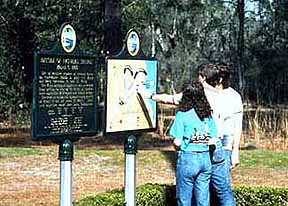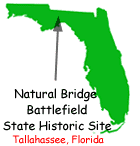 During the final weeks of the Civil War, the Battle of Natural Bridge preserved
Tallahassee as the only Confederate capitol east of the Mississippi River
never to fall into Union hands. Considered quite an accomplishment by historians,
the five-day battle concluded when a motley militia of old men and young
boys defeated seasoned Union troops.
During the final weeks of the Civil War, the Battle of Natural Bridge preserved
Tallahassee as the only Confederate capitol east of the Mississippi River
never to fall into Union hands. Considered quite an accomplishment by historians,
the five-day battle concluded when a motley militia of old men and young
boys defeated seasoned Union troops.
HISTORY
Between March 1 and 3, 1865, a Union flotilla arrived in Apalachee
Bay. General John Newton and Naval Commander William Gibson had a joint
assault plan in mind to cripple Confederate forces. On March 3, 300 seamen
surprised Confederate pickets and captured the East River Bridge, four miles
north of the St. Marks lighthouse. The following day, Navy gunboats commanded
by Gibson ran aground in the shallow waters of the St. Marks River. Gibson
spent the next two days desperately trying to get upstream to Port Leon
but was unsuccessful.
Gibson's unexpected delay provided just enough time for a Confederate
messenger to travel to Tallahassee and warn the citizens of the danger
to the Capitol caused by the Union landing. In an effort to defend the
Capitol, every man and boy who could bear arms volunteered to join the
thin ranks of the Confederate Army. The forces were made up of wounded
confederate soldiers home to recuperate, men as old as 70 and cadets as
young as 14 from West Florida Seminary (now Florida State University).
The Confederate troops, commanded by General William Miller, were taken
to Newport to prepare a defense.
On March 5, Union General Newton advanced past the East River Bridge,
causing Confederate troops from the Fifth Cavalry to withdraw to the Newport
Bridge on the St. Marks River. The Confederate cavalry was joined by the
volunteers from Tallahassee, where they gained enough strength to force
Newton to take a round-about route to Natural Bridge. Miller, who had
second-guessed Newton's attempted surprise crossing, sent Confederate
forces under Lt. Colonel George Scott on an overnight march to defend
the crossing.
In the pre-dawn hours of the following day, a series of skirmishes lasting
about 10 hours occurred along the narrow natural bridge. Confederate forces,
made up of 500 to 700 men, fought off three major attacks and several
minor attempts by Union forces of nearly equivalent strength. The Union
troops, having decided that the bridge was impassable, began a hasty retreat.
By sundown on March 7, Union soldiers were in the protection of their
own fleet. Newton, feeling that he had not been adequately supported by
the Navy, took his troops back to Key West. Union losses totaled 21 killed,
89 wounded and 38 captured. Confederate losses were three killed and 22
wounded.
PICNICS
The area has since then returned to its peaceful tranquility and now offers
visitors the perfect spot for a picnic.
REENACTMENTS
Natural Bridge State Historic Site serves as a monument for the famous battle
that took place at the location. The Battle of Natural Bridge is re-enacted
every year in March on a weekend near the anniversary of the actual battle.
Visitors can view authentic Confederate and Union encampments.

Natural Bridge Battlefield State Historic Site is located six miles east of Woodville, off S.R. 363 on Natural Bridge Road.
For more information, contact
Natural Bridge State Historic Site
1022 Desoto Park Drive
Tallahassee, Florida 32301
(850) 922-6007
View Larger Map




 During the final weeks of the Civil War, the Battle of Natural Bridge preserved
Tallahassee as the only Confederate capitol east of the Mississippi River
never to fall into Union hands. Considered quite an accomplishment by historians,
the five-day battle concluded when a motley militia of old men and young
boys defeated seasoned Union troops.
During the final weeks of the Civil War, the Battle of Natural Bridge preserved
Tallahassee as the only Confederate capitol east of the Mississippi River
never to fall into Union hands. Considered quite an accomplishment by historians,
the five-day battle concluded when a motley militia of old men and young
boys defeated seasoned Union troops.
